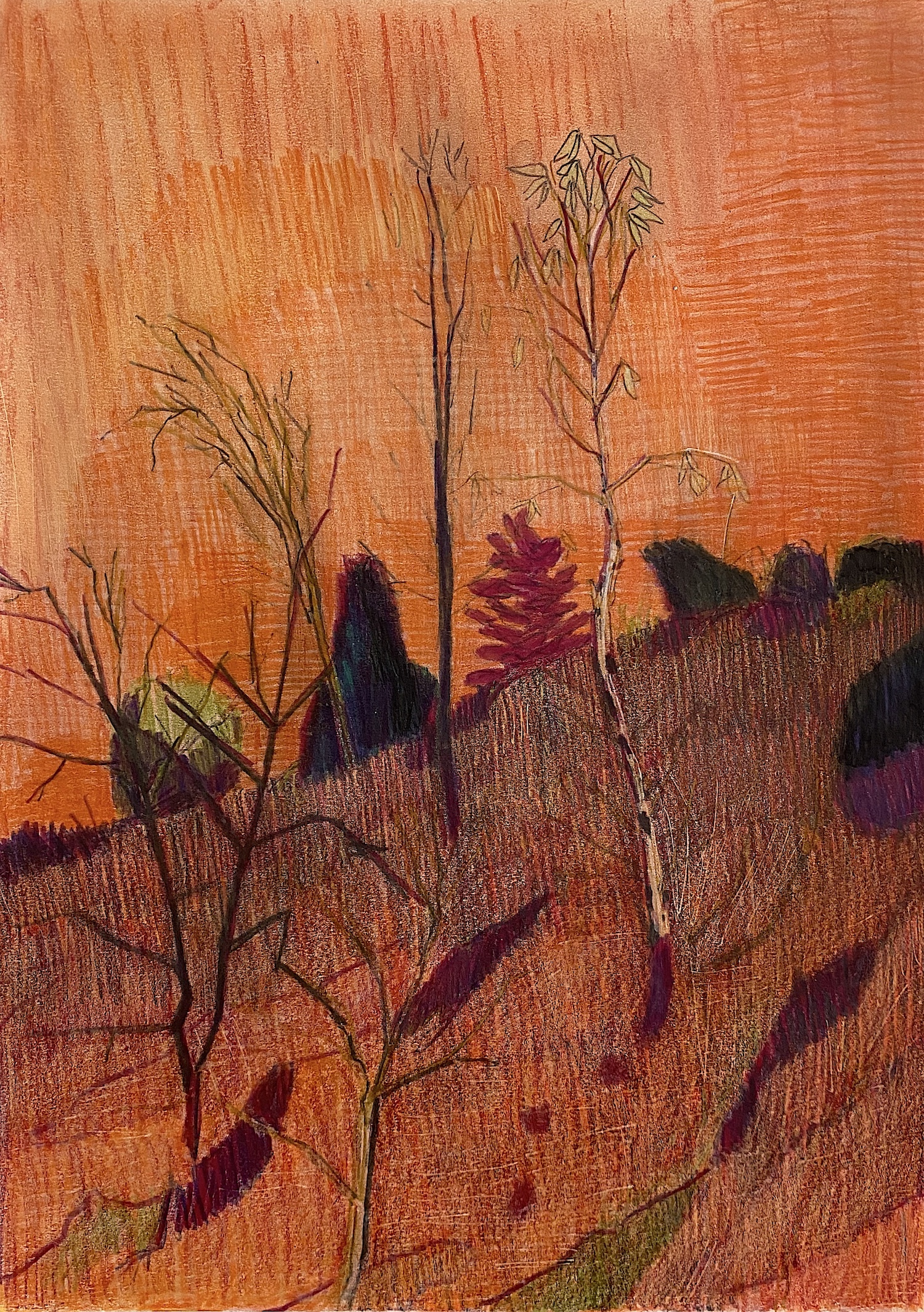Whitehot Magazine
April 2024
"The Best Art In The World"
"The Best Art In The World"
April 2024
Postcards from Per Adolfsen: Portrait Landscapes
 Per Adolfsen, The night angler's vision, 2020, 60 x 42 cm. Colored pencil and graphite on paper. Courtesy of 532 Gallery and the artist
Per Adolfsen, The night angler's vision, 2020, 60 x 42 cm. Colored pencil and graphite on paper. Courtesy of 532 Gallery and the artist
Per Adolfsen: Landscapes
December 3, 2020 through January 16, 2021
By CORI HUTCHINSON, December 2020
Danish artist Per Adolsen’s fibrous pencil illustrations on view at 532 Gallery, much like medieval tapestries, are transportive to scenes that blend the real and perceived. The specificity of each landscape, articulated through contrast, color, form, and pattern, reveal an exterior-turned-interior. As Susan Stewart writes in On Longing: Narratives of the Miniature, the Gigantic, and Souvenir, the Collection, the “reduction of dimensions” of a place to a postcard, for example, “reduces the public, the monumental, and the three-dimension into the miniature, that which can be enveloped by the body, or into the two-dimensional representation, that which can be appropriated within the privatized view of the individual subject.” Adolfsen’s set of recent landscapes, all completed in 2020, turn the notion of the “postcard” or “souvenir” vertical, like rectangular keyholes, construction site viewing panels, without semantic caption or stamp. These drawings, small-scale, intimate, and full of path, execute a similar reduction of public and enlargement of private experience.
 Per Adolfsen, Hiilside, 2020, 42 x 30 cm, colored pencil and graphite on paper. Courtesy of 532 Gallery and the artist
Per Adolfsen, Hiilside, 2020, 42 x 30 cm, colored pencil and graphite on paper. Courtesy of 532 Gallery and the artist
Few included works indicate any material human footprint, though many natural forms throughout are subtly anthropomorphized or bear the shadow of the sender. In one outlier, The night angler’s vision, Adolfsen renders a highly textured space, colored by both night and day, featuring a cloaked reaper-like figure wading through a yellow fluid, evidenced by surrounding ripples. Hidden in the foreground rocks, a stool and canteen are stationed, unattended. The Stream (Water Mirror) extracts the angler (or his nightmare figure, depending on the exact ambiguity of the title) and dissolves the form into several shadows beneath branches. The rightmost shadow, black in the water and magenta on thatched land, appears abstractly like a figure wearing socks; the leftmost shadow, a pair of legs discontinuous at each joint.
Both The Tree and the Play House and Bench by the Sea depict a single artificial structure named in the title, and works like Path behind the lake and September (A Day in the Suburbs) feature manmade borders—hedges, coasts, and trails. The straight lines that define these modified geographies and perimeters invite the viewer to the drawn pathway, allowing them to choose their own miniature adventure to enlarge and enter. Every line is, therefore, a possibility.
 Per Adolfsen, Evening by the Coast, 2020, 42 x 30 cm. Colored pencil, chalk and graphite on paper. Courtesy of 532 Gallery and the artist
Per Adolfsen, Evening by the Coast, 2020, 42 x 30 cm. Colored pencil, chalk and graphite on paper. Courtesy of 532 Gallery and the artist
On the other hand, Evening by the Coast remembers a scene washed in a flat blush with various floating rocks in the apparent foreground. The pink abyss stares back. Most of the line-work in this drawing is concentrated on the tops of stones. Stewart writes that the souvenir “generates a narrative which reaches only ‘behind,’ spiraling in a continually inward movement rather than outward toward the future.” In many of the rocky works, Adolfsen materializes this nostalgic spiral onto the stone faces to signify both concrete endurance and dimension.
In a more overtly fantastical characterization of the pastoral, Curly Trees lies on a globular plane. The foreground grass loosely resembles the drift of Pangea. Blue, purple, and green trees squiggle upward toward a plain blue sky. The density of mark in the darker tones tufts out captivatingly, while the thin, bare branches behind appear to indicate difference, perhaps a seasonal transition more immediately recognizable in works like Hillside, wherein tree shadows double as larger-than-life fallen leaves.
 Per Adolfsen, Curly trees, 2020, 42 x 30 cm, colored pencil and graphite on paper. Courtesy of 532 Gallery and the artist
Per Adolfsen, Curly trees, 2020, 42 x 30 cm, colored pencil and graphite on paper. Courtesy of 532 Gallery and the artist
Unlike traditional postcards with horizontal layout, Adolfson’s two-dimensional scenes utilize verticality in portrait orientation, elongating toward the top of the paper and occasionally stretching beyond it. The tall, narrow scenes and the directionality of the line itself exaggerate the forwardness of the drawing set. The viewer is vaulted into the afar without peripheral distraction. Observation and travel become one secondhand.
Maybe for the artist these drawings indicate a path remembered, but for the fresh viewer, the terrain is very much unexplored. This selection, on the whole, hums with living line, reconciling, as Stewart writes, “the disparity between interiority and exteriority, subject and object, signifier and signified.” Adolfsen’s departure from portraiture proves adventurous, with each drawing acting as a stepping stone into the artist’s past and the viewer’s future. WM

Cori Hutchinson
Cori Hutchinson is a poet, watercolorist, and library assistant living in Brooklyn.
view all articles from this author







